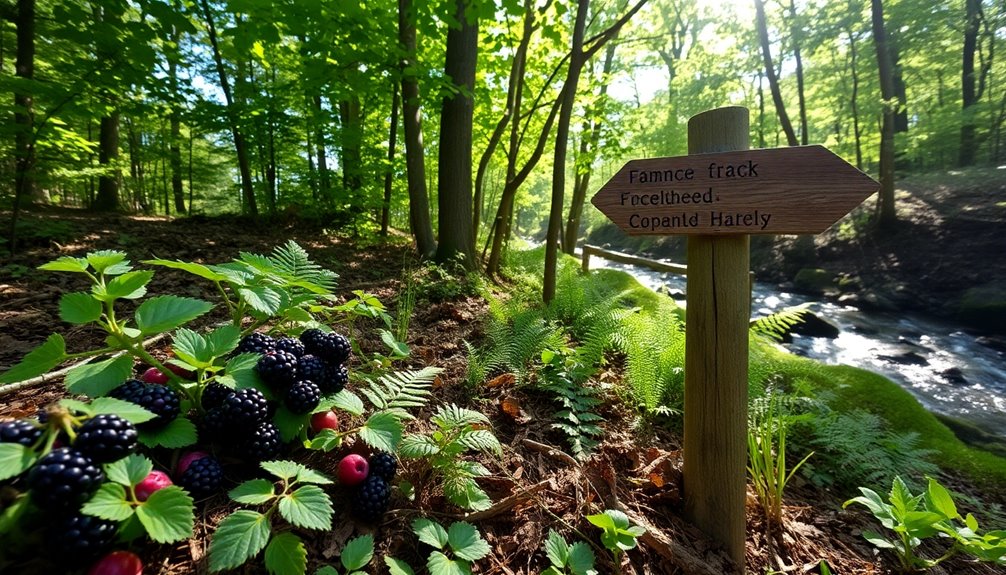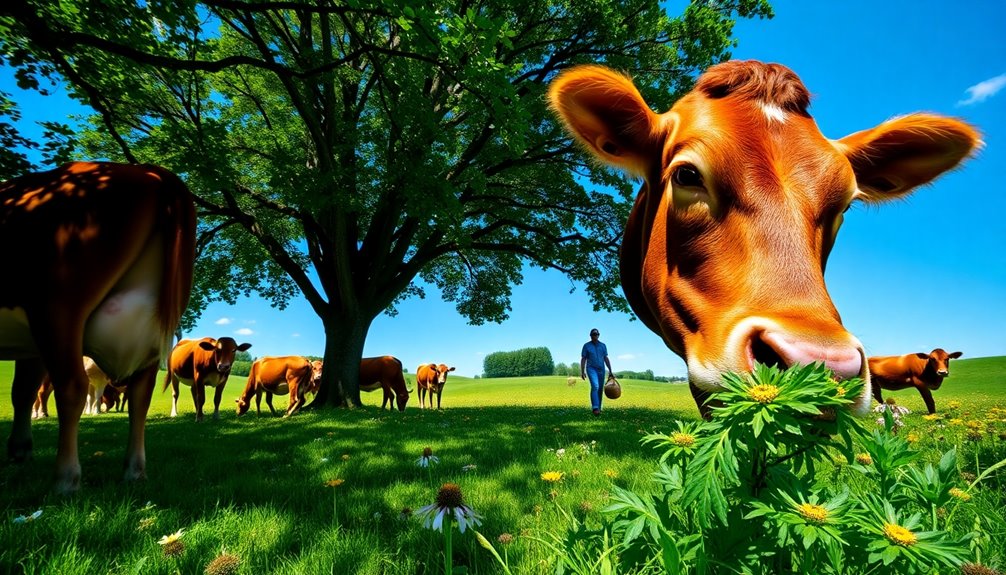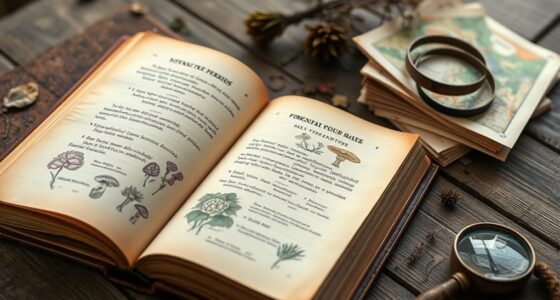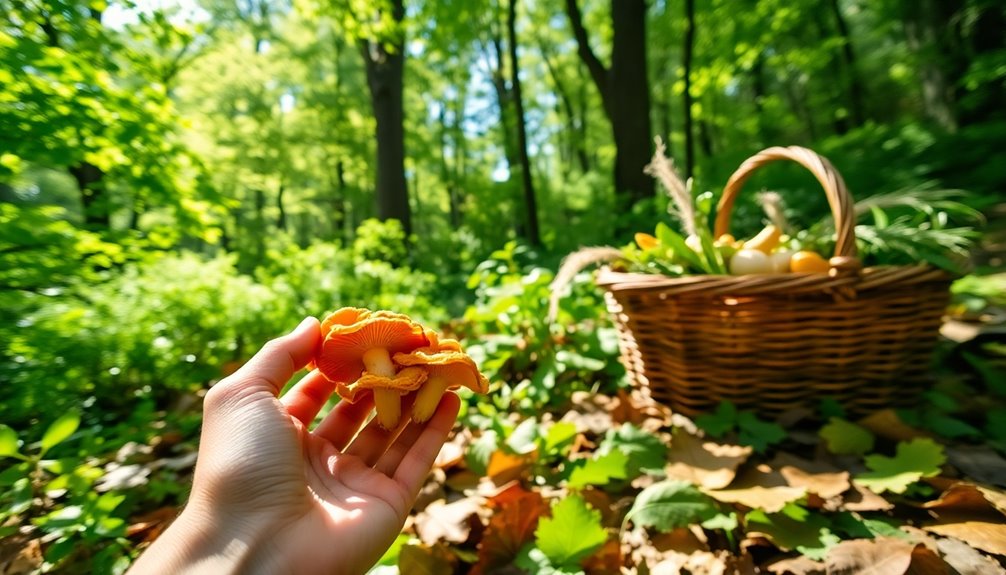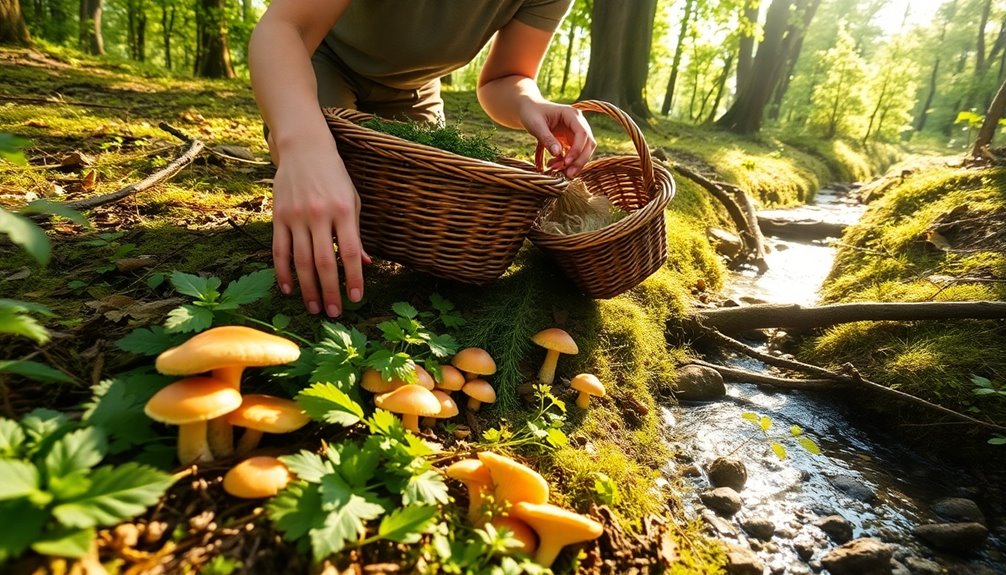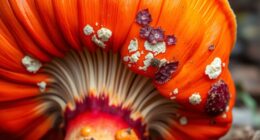Foraging's allowed in various locations, but knowing the regulations is essential. National parks usually prohibit collecting anything, while national preserves often let you gather a limited amount of specific items. In national forests, you'll need a permit, and some species are off-limits. State parks typically ban foraging to protect native flora. Wildlife refuges vary; many allow gathering berries or nuts for personal use. Urban settings may offer wild edibles in local parks and community gardens, while rural areas often have rich forageable landscapes. Stick around, and you'll uncover even more about forager-friendly spots and best practices!
Key Takeaways
- Foraging is generally prohibited in national parks to protect ecosystems, but national preserves allow limited foraging, like blackberries, at 1 gallon/day.
- National wildlife refuges permit personal use of berries, fruits, and nuts, with varying regulations across different refuges.
- National forests require permits for foraging, starting at $20, with specific species restrictions, including a ban on American Ginseng.
- Urban areas offer diverse foraging opportunities in community gardens and local parks, with seasonal patterns enhancing wild edible gathering success.
- State parks typically ban foraging to protect native flora, while rural areas provide rich landscapes for wild edibles, needing landowner permission.
Foraging Regulations Overview
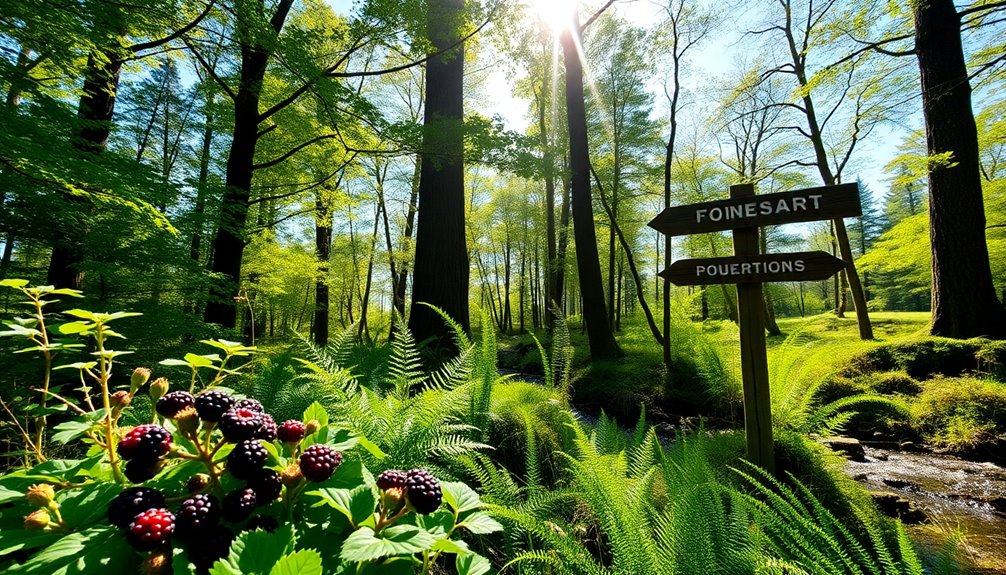
When it comes to foraging regulations, understanding the rules is vital for a successful and responsible harvest. Each location has its own guidelines, and knowing these can help you avoid fines and protect ecosystems.
In national parks, foraging is generally prohibited to safeguard native plants. However, national preserves may allow you to forage specific species, like blackberries and walnuts, with a limit of 1 gallon per day per species for personal use.
If you're considering foraging in national forests, remember you'll need a permit, which starts at $20. Be cautious, as some species, such as American Ginseng, are entirely off-limits.
State parks often have stricter rules, frequently banning all foraging to protect local flora.
On the flip side, the Tennessee Valley Authority permits foraging for personal use without a permit, but you must avoid disturbing the ground or removing entire plants—mushrooms being an exception.
National Parks and Preserves
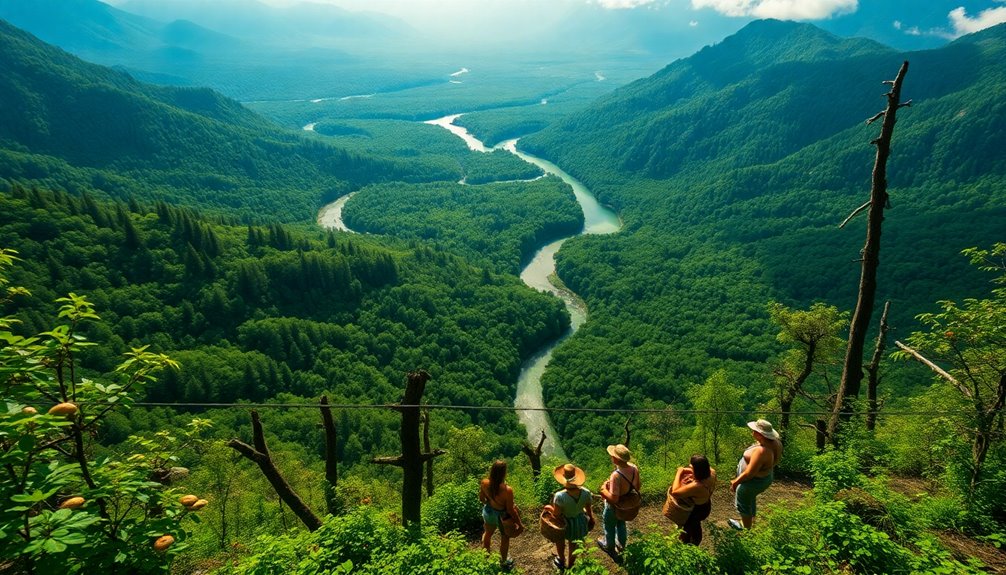
Exploring national parks and preserves offers a unique opportunity to connect with nature, but it's crucial to understand the foraging rules in these areas. Generally, foraging is prohibited in most national parks to protect ecosystems. However, national preserves, like Little River Canyon, have specific allowances for certain edible species.
| Location | Foraging Allowed |
|---|---|
| National Parks | Generally prohibited |
| Little River Canyon Preserve | Blackberries, hickory nuts (1 gallon/day) |
| Other National Preserves | Limited fruits and nuts, hand collection only |
| National Wildlife Refuges | Berries, fruits, and nuts for personal use only |
In national preserves, you can collect up to 1 gallon per day of certain fruits and nuts, but always check local regulations. It's important to forage responsibly—harvesting should be done by hand and only for personal use. Remember, preserving these natural spaces is just as significant as enjoying them. So, before you head out, familiarize yourself with the specific rules of the area you plan to visit to guarantee a respectful and enjoyable foraging experience.
National Forests Foraging Rules
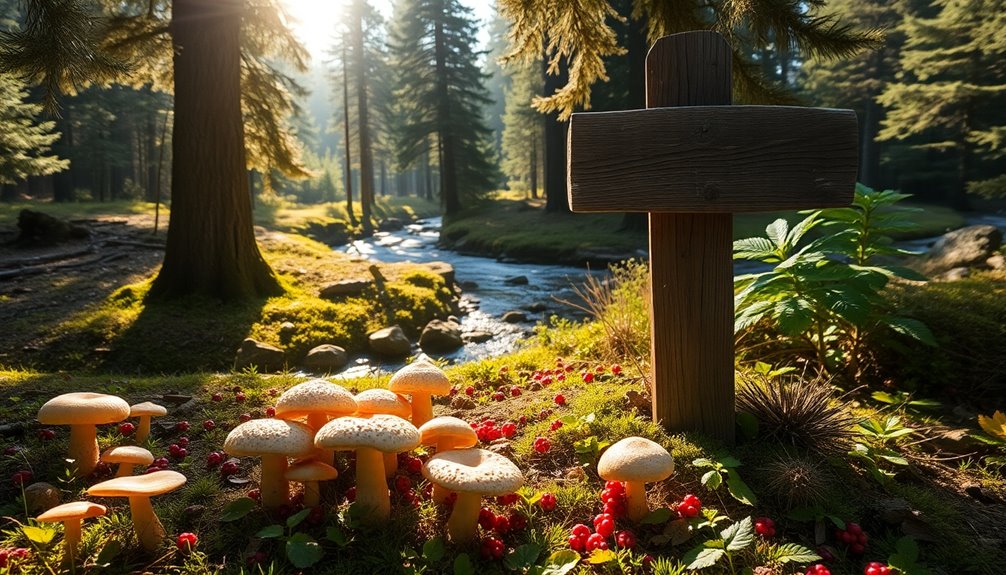
When foraging in National Forests, it's essential to understand the specific rules and limits that apply to what you can collect.
You may need a permit for certain areas, like Bankhead National Forest, while others allow foraging within set limits for items like mushrooms and berries.
Always check with local offices to guarantee you're following the regulations and protecting vulnerable species.
Permits and Regulations Overview
Foraging in National Forests requires maneuvering a set of specific permits and regulations to secure sustainable practices.
To start foraging, you need to obtain a permit from the Forest Service, which you can purchase in person for as little as $20. Keep in mind that these permits need to be renewed annually.
It's also important to know that some species, like American Ginseng, are completely banned from harvest in National Forests, so be sure to familiarize yourself with the restrictions.
The regulations for mushroom foraging vary by location, making it necessary to consult your local Forest Service office for specific guidelines.
Generally, foraging is limited to personal use, and there are often restrictions on the quantities you can collect. This emphasis on sustainability and conservation is essential to preserving the natural ecosystem for future generations.
Staying informed about local rules and potential restrictions not only helps you avoid fines but also guarantees that you're practicing responsible foraging.
Before heading out, double-check the guidelines to enjoy a successful and sustainable foraging experience in National Forests.
Allowed Species and Limits
Maneuvering the rules for allowed species and limits in National Forests can be essential for a successful foraging experience. Before you head out, remember that foraging typically requires a permit, which you can purchase from the Forest Service for around $20.
Each National Forest has its specific regulations, especially concerning mushrooms, so it's wise to consult the local office for clarity on which species are permissible.
Some species, like American Ginseng, are completely banned from harvest to protect their populations. For personal use, you can often collect a limited quantity of edible plants—usually capped at 1 gallon per day for certain species—but this limit can vary by forest.
Make sure to check the local National Forest office for detailed regulations and additional restrictions that may apply.
While you may find foraging opportunities in parks, state parks, and nature preserves, each location may have its own set of rules. Understanding these guidelines will help you enjoy a safe and rewarding foraging experience, ensuring you respect the ecosystem while gathering your finds.
Wildlife Refuges and Foraging

When foraging in wildlife refuges, it's important to know which species you can collect and the specific regulations in place.
Each refuge has its own set of rules regarding what's allowed, especially regarding seasonal guidelines.
Before you head out, make certain to review the visitor activity guidelines to guarantee a responsible and enjoyable foraging experience.
Allowed Foraged Species
Exploring the diverse foraging opportunities in National Wildlife Refuges can be rewarding, but it's crucial to know what's allowed. Generally, foraging isn't permitted in these areas; however, some refuges do allow specific collection of berries, fruits, and nuts for personal use. Each refuge has its own guidelines, so be sure to check the specific rules for the area you plan to forage in.
Some refuges may permit the collection of mushrooms, but the regulations vary widely. Always consult the refuge's rules to avoid any surprises. The US Fish and Wildlife Service oversees these regulations, prioritizing the protection of wildlife habitats while allowing limited foraging.
It's significant to note that there may be restrictions on the quantity you can collect, often limited to a specific number per day. Additionally, remember that foraging on private properties requires permission from the landowner, as this differs from public refuge rules.
Always verify the current foraging policies with refuge management to avoid fines or penalties for illegal harvesting. Being informed guarantees you can enjoy your foraging adventures responsibly!
Collection Regulations
Foraging in wildlife refuges comes with specific collection regulations that vary considerably from one refuge to another. Generally, foraging isn't permitted, but some refuges allow the collection of berries, fruits, and nuts for personal use. For instance, Wheeler National Wildlife Refuge permits foraging for these items, while others may have different rules, particularly regarding mushroom collection.
It's important to remember that foraging in these areas is governed by the U.S. Fish and Wildlife Service. This means you need to check each refuge's unique regulations, as they can change based on local guidelines. Before you head out, consult the visitor activity guidelines for each refuge to understand what types of collection are allowed and any limits on quantities.
To avoid illegal harvesting and potential fines, familiarize yourself with the management policies of the specific wildlife refuges you plan to visit. By doing your research, you guarantee that your foraging experience is enjoyable and compliant with the law.
Seasonal Foraging Guidelines
Understanding seasonal foraging guidelines is essential for anyone looking to collect natural resources in wildlife refuges. Each refuge has its own set of rules, so it's important to check the specific regulations before you head out.
Most wildlife refuges allow the collection of berries, fruits, and nuts for personal use, but some may impose restrictions on other foraged items like mushrooms.
For instance, Wheeler National Wildlife Refuge permits the gathering of certain berries and nuts, but not all refuges share this leniency. Some may completely prohibit foraging activities to safeguard local flora and fauna. As a result, always confirm the guidelines for the particular refuge you plan to visit.
To stay informed about seasonal foraging opportunities and regulations, engage with community resources and newsletters related to the refuges. They often provide up-to-date information that can enhance your foraging experience while ensuring you're compliant with local laws.
State Parks and Access
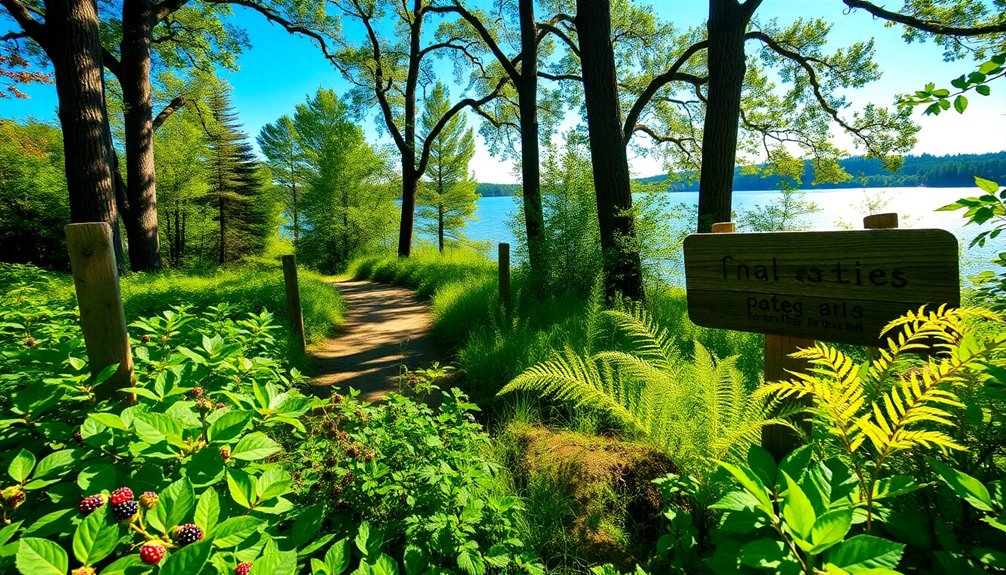
State parks offer a beautiful backdrop for outdoor activities, but when it comes to foraging, the rules can be quite strict. In Texas state parks, for instance, foraging is generally prohibited to protect native flora. These regulations emphasize the importance of preserving plant species, guaranteeing that ecosystems remain intact.
While some parks may host educational programs or guided foraging tours, personal collection of any resources without explicit permission isn't allowed.
It's crucial to remember that each state park has its own set of rules regarding foraging. Before you plan a visit, check with park management for any exceptions or updates on foraging policies. Violating these regulations can lead to fines or penalties, so it's best to stay informed.
If you're enthusiastic to forage, consider exploring nearby public lands or community gardens. These areas might offer alternative foraging opportunities with the right research and permissions.
Always respect the local regulations and the environment to guarantee that future generations can enjoy the natural beauty that surrounds us. Happy foraging, but always play it safe and legal in state parks!
Urban Foraging Opportunities
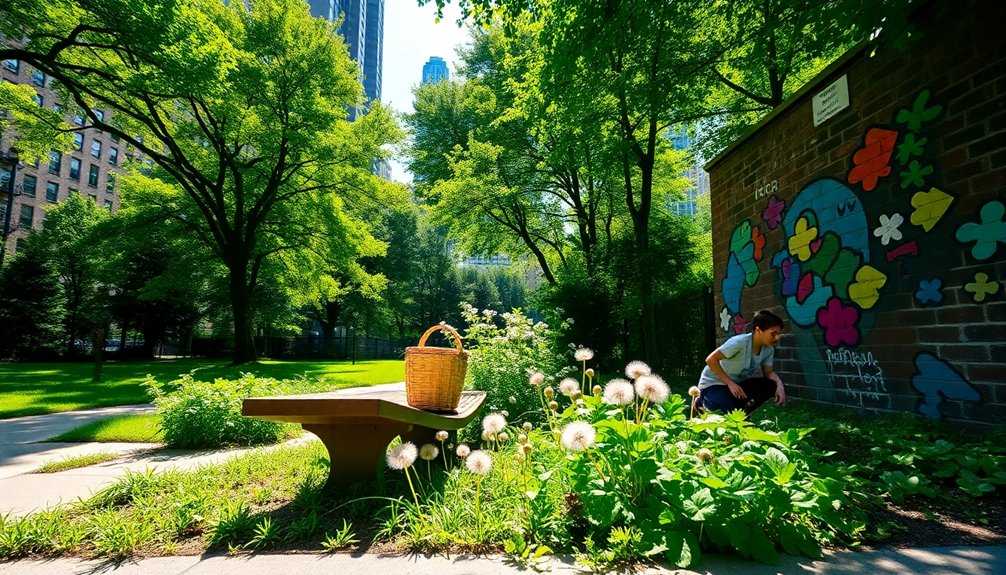
While state parks may have strict foraging regulations, urban environments can offer a wealth of opportunities for those looking to gather wild edibles. You might be surprised at how many options are available right in your city.
From community gardens to local parks, there's plenty of potential for foraging. Here are some great spots to explore:
- Farmers markets: Many feature wild foods and edible invasive species you can harvest with permission.
- Neighborhood scouring: Look for wild plants like lambs quarters and serviceberries that thrive in urban settings. Understanding seasonal growth patterns can significantly enhance your foraging success.
- Community gardens: These shared spaces often allow access to a variety of edible plants.
- Parks: Local parks frequently have wild edibles waiting to be discovered.
- Farm meadows and fencerows: With the farmer's permission, these areas can yield interesting foraging finds.
As landscape architects increasingly incorporate renewable energy sources into urban designs, your foraging opportunities are expanding.
Rural Foraging Locations
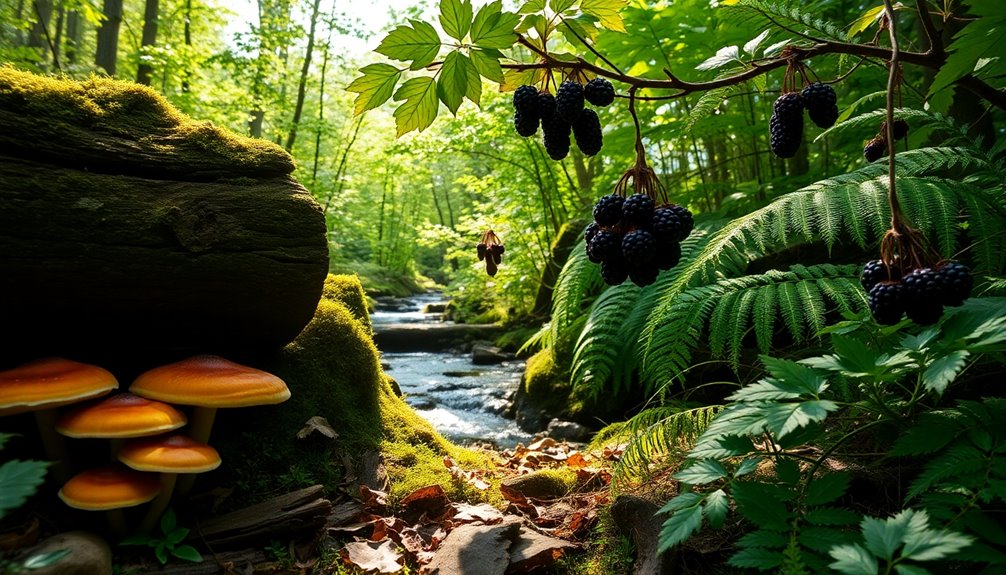
Rural foraging locations offer a treasure trove of wild edibles waiting to be discovered. In Texas, for example, the diverse landscapes of forests, fields, and meadows are prime foraging spots. You'll find abundant wild plants and mushrooms here, just waiting for you to explore.
While scouting these rural areas, don't forget to seek permission from landowners when foraging on private properties. Websites like HipCamp.com can help you locate potential spots.
As you wander through farm meadows or along fencerows, keep your eyes peeled for berries, nuts, and herbs. Local guides and community knowledge are invaluable in identifying these wild edibles.
Be mindful of the regulations in your area, as some species may be protected or require permits for collection. Engaging with the local community can enhance your foraging experience, providing insights into the best spots and seasonal availability.
Community Resources and Education
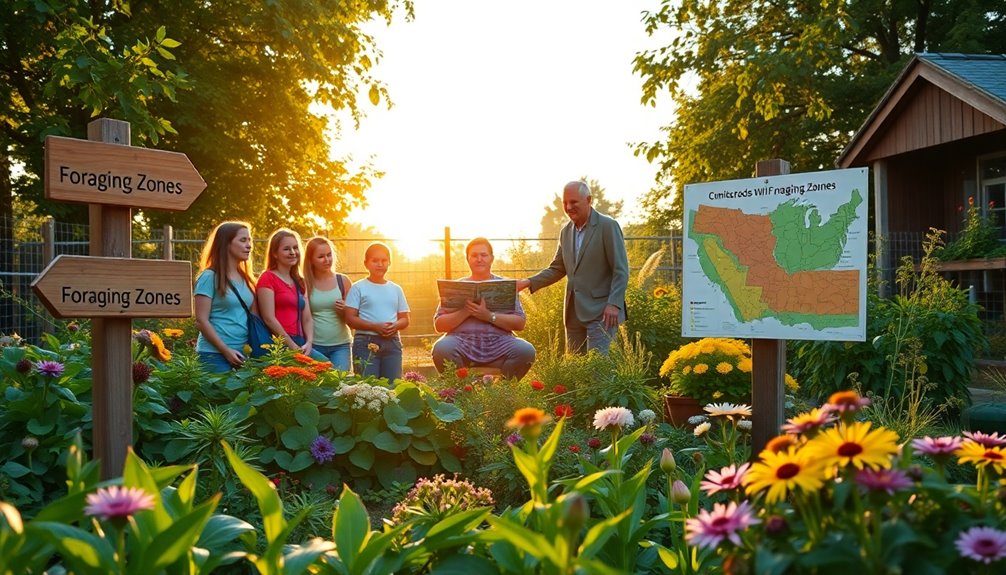
Immerse yourself in the wealth of community resources and education available for foragers enthusiastic to enhance their skills and knowledge. Connecting with local foraging groups can be essential, as they often provide support and share crucial information about sustainable harvesting practices and locations. Additionally, understanding the importance of emotional alignment can enhance your foraging experience, as it helps maintain a positive mindset while connecting with nature. Engaging with these groups can also support collaboration and teamwork, fostering a sense of community among foragers.
You can also take advantage of various educational opportunities, including:
- Foraging classes at community centers or online platforms, focusing on techniques and plant identification.
- Volunteer opportunities that promote edible invasive removal and wild edible education in local parks and gardens.
- Seasonal guides, like "Foraging through the Seasons," available for download, keeping you updated on what's in season.
- Interactive platforms, such as Discord, where you can connect with other foragers to share experiences and tips.
- Workshops and events that foster community engagement and provide hands-on learning experiences. Additionally, many foraging groups promote the principles of Leave No Trace, ensuring that foragers minimize their environmental impact while enjoying nature.
Frequently Asked Questions
Is Foraging Allowed in National Parks?
Foraging isn't allowed in national parks. These areas focus on conserving natural resources, and the rules are strict to protect the ecosystem.
You may find some national preserves that permit limited foraging, like gathering blackberries or nuts, but you'll need to check specific regulations.
Always consult the Superintendent's Compendium to understand what's permitted. Violating these rules can lead to hefty fines, so it's essential to follow the guidelines.
Is Foraging Legal in the US?
Foraging's legal status in the U.S. varies by state and location. You need to check local regulations, as some areas allow it with restrictions, while others completely prohibit it.
In many national parks, foraging isn't allowed and can lead to hefty fines. Always get landowner permission when foraging on private property.
Educating yourself about the rules in your area guarantees you forage legally and sustainably while enjoying nature.
Where Is It OK to Forage?
Imagine wandering through lush landscapes, your basket ready to collect nature's bounty.
You can forage in Texas National Forests, where you're allowed up to 1 gallon of mushrooms or 1 pint of fruits, nuts, or berries daily.
In community gardens and urban parks, check local rules first.
Don't forget about private land—just make sure to get the landowner's permission.
Always remember to respect specific park regulations to protect our precious flora.
Where Can You Forage in the US?
You can forage in various places across the U.S. Foraging's typically allowed on private properties if you have the landowner's permission.
In Texas National Forests, you can collect specific amounts of mushrooms and fruits daily for personal use.
Some National Wildlife Refuges permit gathering berries, fruits, and nuts, but always check local regulations first.
Conclusion
To sum up, whether you're wandering through a national park or scouring your local urban landscape, foraging can be a rewarding adventure. Just remember to play by the rules and respect the environment. With a little research and community support, you'll find that the world is your oyster when it comes to foraging opportunities. So grab your basket, keep your eyes peeled, and enjoy the great outdoors while discovering nature's hidden treasures!

